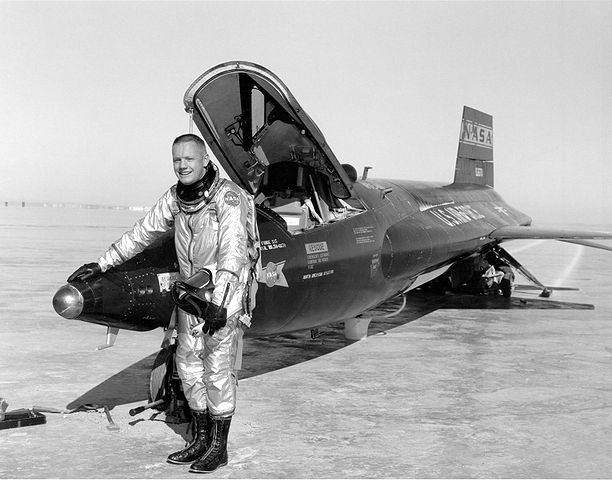
File:Pilot Neil Armstrong and X-15 -1 - GPN-2000-000121.jpg

| |
This is a file from the Wikimedia Commons. Information from its description page there is shown below.
Commons is a freely licensed media file repository. You can help. |
| Description |
English: (1960) Dryden pilot Neil Armstrong is seen here next to the X-15 ship #1 (56-6670) after a research flight. Armstrong made his first X-15 flight on November 30, 1960, in the #1 X-15. He made his second flight on December 9, 1960, in the same aircraft. This was the first X-15 flight to use the ball nose, which provided accurate measurement of air speed and flow angle at supersonic and hypersonic speeds. The servo-actuated ball nose can be seen in this photo in front of Armstrong's right hand. The X-15 employed a non-standard landing gear. It had a nose gear with a wheel and tire, but the main landing consisted of skids mounted at the rear of the vehicle. In the photo, the left skid is visible, as are marks on the lakebed from both skids. Because of the skids, the rocket-powered aircraft could only land on a dry lakebed, not on a concrete runway.
The X-15 was a rocket-powered aircraft. The original three aircraft were about 50 ft long with a wingspan of 22 ft. The modified #2 aircraft (X-15A-2 was longer.) They were a missile-shaped vehicles with unusual wedge-shaped vertical tails, thin stubby wings, and unique side fairings that extended along the side of the fuselage. The X-15 weighed about 14,000 lb empty and approximately 34,000 lb at launch. The XLR-99 rocket engine, manufactured by Thiokol Chemical Corp., was pilot controlled and was rated at 57,000 lb of thrust, although there are indications that it actually achieved up to 60,000 lb. North American Aviation built three X-15 aircraft for the program. The X-15 research aircraft was developed to provide in-flight information and data on aerodynamics, structures, flight controls, and the physiological aspects of high-speed, high-altitude flight. A follow-on program used the aircraft as testbeds to carry various scientific experiments beyond the Earth's atmosphere on a repeated basis. For flight in the dense air of the usable atmosphere, the X-15 used conventional aerodynamic controls such as rudder surfaces on the vertical stabilizers to control yaw and movable horizontal stabilizers to control pitch when moving in synchronization or roll when moved differentially. For flight in the thin air outside of the appreciable Earth's atmosphere, the X-15 used a reaction control system. Hydrogen peroxide thrust rockets located on the nose of the aircraft provided pitch and yaw control. Those on the wings provided roll control. Because of the large fuel consumption, the X-15 was air launched from a B-52 aircraft at approximately 45,000 ft and a speed of about 500 mph. Depending on the mission, the rocket engine provided thrust for the first 80 to 120 sec of flight. The remainder of the normal 10 to 11 min. flight was powerless and ended with a 200-mph glide landing. Generally, one of two types of X-15 flight profiles was used; a high-altitude flight plan that called for the pilot to maintain a steep rate of climb, or a speed profile that called for the pilot to push over and maintain a level altitude. The X-15 was flown over a period of nearly 10 years -- June 1959 to Oct. 1968 -- and set the world's unofficial speed and altitude records of 4,520 mph (Mach 6.7) and 354,200 ft in a program to investigate all aspects of manned hypersonic flight. Information gained from the highly successful X-15 program contributed to the development of the Mercury, Gemini, and Apollo manned spaceflight programs, and also the Space Shuttle program. The X-15s made a total of 199 flights, and were manufactured by North American Aviation. X-15-1, serial number 56-6670, is now located at the National Air and Space Museum, Washington DC. North American X-15A-2, serial number 56-6671, is at the United States Air Force Museum, Wright-Patterson AFB, Ohio. X-15-3, serial number 56-6672, crashed on 15 November 1967, resulting in the death of Maj. Michael J. Adams.Česky: Zkušební pilot Neil Armstrong po letu pózuje před experimentálním letounem X-15 č. 1 (56-6670). High-Speed Flight Station (dnes Drydenovo letecké výzkumné středisko) na Edwardsově základně v Kalifornii. 1. ledna 1960.
|
||||||
| Date | 1 January 1960 | ||||||
| Source | Great Images in NASA Description | ||||||
| Author | NASA | ||||||
| Permission ( Reusing this file) |
|
| This image or video was catalogued by Dryden Flight Research Centre of the United States National Aeronautics and Space Administration (NASA) under Photo ID: E60-6286 AND Alternate ID: GPN-2000-000121. This tag does not indicate the copyright status of the attached work. A normal copyright tag is still required. See Commons:Licensing for more information. |
 |
Personality rights warning |
File usage
A background to Schools Wikipedia
Schools Wikipedia has been carefully checked to give you the best learning experience. More than 2 million people benefit from the global charity work of SOS Childrens Villages, and our work in 133 countries around the world is vital to ensuring a better future for vulnerable children. There are many ways to help with SOS Children's Villages.



